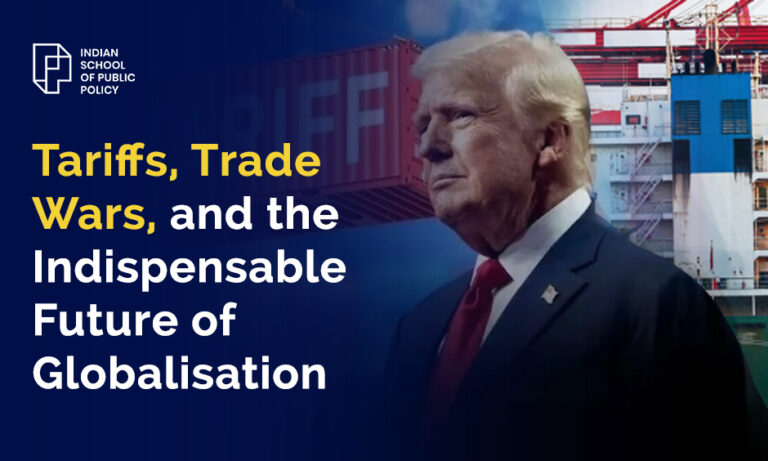Table of Contents
Tariffs, Trade Wars, and the Indispensable Future of Globalisation

As part of its weekly Friday Forum Guest Lecture series, the Indian School of Public Policy (ISPP) was honored to host Mr. Anup Wadhawan, former Commerce Secretary to the Government of India and an eminent economist, on September 26th. His session on ‘Tariffs, Trade Wars, and the Future of Globalisation’ offered a sharp, evidence-based critique of modern protectionism and a clear-eyed perspective on India’s path forward.
The False Promise of Protectionism
Mr. Wadhawan’s core argument began with the inefficiency of closed economies. A protected system epitomised by decades-long 100% duty on India’s automobile sector led to higher consumer costs, lower quality, and stifled innovation. Protectionism hinders the benefits of comparative advantage and economies of scale, ultimately making a country uncompetitive and decoupling it from vital Global Value Chains (GVCs).
Instead of persistent tariffs, he advocated for short-term, self-extinguishing subsidies that offer temporary support but mandate eventual competitiveness. The undisputed consensus, he noted, is that the gains from openness are real; the social problem is the need to cushion the “losers” of free trade, not abandon the policy itself.
Deconstructing the US Trade Deficit
The session then turned to the catalyst for today’s trade turmoil: the Trump-era tariffs. The premise that the US is being ‘cheated’ is unfounded. Mr. Wadhawan highlighted that the US trade deficit is not a sign of poor trading terms, but a macroeconomic phenomenon, a reflection of US investment exceeding domestic savings and insatiable consumption far outpacing domestic output.
Furthermore, promising a return to manufacturing jobs via tariffs is unviable. Given a high-wage, full-employment labour market, such policies only risk stagflation and force the world to carve out supply chains outside the US, undermining America’s competitiveness. This is, in effect, a “mindless undoing of the most impressive growth success story in history.”
India’s Real Constraints
While Trump’s tariffs on Indian goods (especially labour-intensive sectors like textiles) pose a medium-term impact, the hard truth is that they are not the binding constraint on India’s economic ambition.
Manufacturing has disappointingly dropped to 13% of India’s GDP. Our focus must pivot from external trade wars to internal reforms. The real hurdles remain the long-persistent domestic shortcomings: an unfriendly investment environment, challenges in resolving issues across power, agriculture, and municipal services, and the historical failure of platforms like Special Economic Zones (SEZs).
Globalisation is Here to Stay
Global Value Chains, based on the immutable principle of cost minimisation through specialisation, are here to stay. They may evolve, but they are as fundamental to modern economics as Adam Smith himself.
The takeaway for students and policymakers is clear: while global trade skirmishes make headlines, India’s long-term economic performance hinges on our domestic competitiveness and our political economy’s capacity for structural reform, not on external tariffs.



